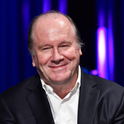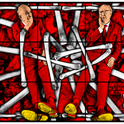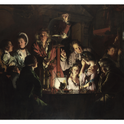Jazz is everywhere in 2025. At clubs and festivals, listening bars and art galleries, the playlists of taste-making radio stations. In magazines such as The Wire and We Jazz. Record labels like Trunk, Brownswood, Jazzman and Jazz in Britain issue new and long-lost treasures almost monthly. (My favourite? A New Life: Private, Independent and Youth Jazz in Great Britain 1966-1990.) More and more books are published—from collections of rare Japanese jazz sleeve art to André Marmot’s Unapologetic Expression and Emma Warren’s Make Some Space, both of which track the contemporary UK scene. Even the political language of our time is peppered with words—breathing, improvisation, collectivity—that have always been sacred to jazz.
What about cinema? It has a long history with jazz. Both are 20th-century art forms that rose in tandem. Need one mention the first talkie, Alan Crosland’s The Jazz Singer, from 1927? Genres such as noir are scarcely imaginable without jazz, which, more than supplying its soundtrack, forms its moodscape: night time, underworlds, louche behaviour, sordid sophistication, cruel modernity, exquisite loss. A canon of sorts has emerged: biopics including Michael Curtiz’s Young Man with a Horn (1950), starring Kirk Douglas as Bix Beiderbecke, and Clint Eastwood’s Bird (1988) about Charlie Parker; concert films such as Bert Stern’s Jazz on a Summer’s Day (1959) about the previous year’s Newport Jazz Festival; Francis Ford Coppola’s rollicking crime drama The Cotton Club (1984).
Jazz cinema is at its most compelling when it chafes against the culture into which it was born. Johan Grimonprez’s Soundtrack to a Coup d’Etat (2024), made entirely from archival footage, looks at how the music was deployed as a tool of soft power by the CIA in the late 1950s and early 1960s. This was when, as Harold Macmillan famously declared, the “winds of change” were blowing across Africa. In newly independent Congo, charismatic prime minister Patrice Lumumba terrified the Belgian establishment, who informed the Eisenhower administration it risked losing access to the country’s uranium reserves, which the US needed to make atomic bombs. While mercenaries and local military squads were tasked with killing Lumumba, Louis Armstrong, Nina Simone, Duke Ellington and Dizzy Gillespie were playing concerts to tens of thousands of people in Congo and in other African countries. Perhaps they saw their shows as homecomings? Stirred by the emergent civil rights movement, making connections between anti-colonialism abroad and life in segregated America, jazz musicians were becoming restless: Gillespie spoke of his trumpet as a “weapon”; Ellington asserted, “This is not a piano. This is dreaming.” Neither knew that their paymasters saw them as “ambassadors” for American culture or that their music was meant to make the US look cool in its Cold War against Khrushchev.
‘This is not a piano. This is dreaming.’
This is a complex, multi-dimensional story that Grimonprez brings to fiery life through dynamic, rhythmic editing, graphics that recall the sleeves of Impulse! LPs, and by repeated switches to exhilarating footage of Max Roach and Abbey Lincoln performing their We Insist! Freedom Now Suite album. It also has two powerful codas—one featuring Roach and Lincoln, together with others, disrupting a session of the UN Security Council to protest the assassination of Lumumba in 1961; the other identifying modern-day American tech giants, such as Apple, whose smartphones are made from Congolese critical materials.
The wildest jazz film ever made is John Coney’s Space is the Place (1974), which explores the cosmology of saxophonist Herman Blount, who, born in Alabama in 1914, went by the name of Sun Ra. He claimed to be an alien from Saturn, was obsessed with freemasonry and founded a troupe (named variously as the Myth Science Arkestra, Solar Myth Arkestra, Astro Infinity Arkestra) that unleashed dozens of free-ranging, heliocentric-themed albums that mapped out a vision of Afrofuturism not just before Black Panther, but before the term itself had been coined.
Space is the Place begins on another planet. “The music is different here,” intones Sun Ra, caped and plumed like a disco-loving ancient pharaoh. “The vibrations are different. Not like planet Earth.” The landscape around him is tropical, surreal. Odd shapes swim through the air. There is talk of isotopes, teleportation, transmolecularisation. Soon he’s on Earth—in a desert playing cards with a pimp-like “Overseer”, in Oakland before a group of befuddled black youngsters whom he tries to interest in planetary exodus, at a concert where Nasa scientists try to assassinate him. Almost every frame is bonkers, a profusion of ideas, a joyful noise.
Not a few jazz players have left the US—among them trumpeter Don Cherry to Stockholm, pianist Bud Powell to Paris—to escape addictions, racism, critical indifference. Bertrand Tavernier’s gorgeous, smoky Round Midnight (1986) celebrates the French capital as a sanctuary for such artists. Rewind & Play (2022), by Alain Gomis, constructed from behind-the-scenes footage of Thelonious Monk appearing on a French TV show in 1969, tells a different story.
The pianist’s interviewer, apparently a long-time friend, asks him about an earlier trip to Paris. When Monk replies that he didn’t get paid as much as other musicians, his pal becomes nervous—“We can erase that.” Monk plays, beautifully, but he’s also trapped by the studio spotlights, dripping sweat, his eyes bloodshot, uncertain as to what the show’s technicians are saying about him. He’s praised in dubious terms—for his physique, for his “relaxed” way of looking at the world. Gomis’s exacting use of zooms, freeze frames and silence will leave viewers wanting to cry: set Monk free!
Here is a new sensibility emerging
What about us? In the early 1950s, many British commentators saw jazz as a menace. Too American. As vulgar as fast food. Their anxieties were probably not allayed by Momma Don’t Allow (1956), a heady short by Free Cinema pioneers Karel Reisz and Tony Richardson, that captures a Chris Barber Band show at the Wood Green Jazz Club in north London. It’s the punters who fascinate the directors: a butcher, a dentist’s assistant and a train-carriage cleaner—earnest toilers who seek release from their working lives on the dance floor. At first, the venue—the Fishmongers’ Arms—is quiet, the mood tentative; soon the tempo picks up, collars are let down, hips begin to shake frantically. Here, in miniature, is a new sensibility emerging. A youthquake is on the horizon.
In the end, it was rock ’n’ roll, rather than jazz, that captured the nation’s hearts. Still, Antoine Prum’s wonderful Taking the Dog for a Walk (2014) honours those Brits—among them Eddie Prévost, Max Eastley and Steve Beresford—who went off script, evolving what became known as free improvised music. Guitarist Derek Bailey claimed they were “playing without history”. No swing, no blues notes. Instead—plink, plonk, scratch. Was it noise? It certainly veered towards Dada or even Goons-style absurdism. Prum shows drummer Mark Sanders duetting with a bingo caller, and, in footage both funny and terrifying, vocalist Phil Minton creates a din that sounds like choking, retching, possession.
These cultural outriders are fearless, as distant from Dixieland—or even Ronnie Scott’s—as is imaginable. Yet, like all jazz musicians—and the best jazz cinema—they convey a transfixing sense of being in place, in time. Of being themselves.













